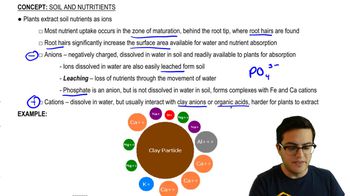Table of contents
- 1. Introduction to Biology2h 42m
- 2. Chemistry3h 40m
- 3. Water1h 26m
- 4. Biomolecules2h 23m
- 5. Cell Components2h 26m
- 6. The Membrane2h 31m
- 7. Energy and Metabolism2h 0m
- 8. Respiration2h 40m
- 9. Photosynthesis2h 49m
- 10. Cell Signaling59m
- 11. Cell Division2h 47m
- 12. Meiosis2h 0m
- 13. Mendelian Genetics4h 44m
- Introduction to Mendel's Experiments7m
- Genotype vs. Phenotype17m
- Punnett Squares13m
- Mendel's Experiments26m
- Mendel's Laws18m
- Monohybrid Crosses19m
- Test Crosses14m
- Dihybrid Crosses20m
- Punnett Square Probability26m
- Incomplete Dominance vs. Codominance20m
- Epistasis7m
- Non-Mendelian Genetics12m
- Pedigrees6m
- Autosomal Inheritance21m
- Sex-Linked Inheritance43m
- X-Inactivation9m
- 14. DNA Synthesis2h 27m
- 15. Gene Expression3h 20m
- 16. Regulation of Expression3h 31m
- Introduction to Regulation of Gene Expression13m
- Prokaryotic Gene Regulation via Operons27m
- The Lac Operon21m
- Glucose's Impact on Lac Operon25m
- The Trp Operon20m
- Review of the Lac Operon & Trp Operon11m
- Introduction to Eukaryotic Gene Regulation9m
- Eukaryotic Chromatin Modifications16m
- Eukaryotic Transcriptional Control22m
- Eukaryotic Post-Transcriptional Regulation28m
- Eukaryotic Post-Translational Regulation13m
- 17. Viruses37m
- 18. Biotechnology2h 58m
- 19. Genomics17m
- 20. Development1h 5m
- 21. Evolution3h 1m
- 22. Evolution of Populations3h 52m
- 23. Speciation1h 37m
- 24. History of Life on Earth2h 6m
- 25. Phylogeny2h 31m
- 26. Prokaryotes4h 59m
- 27. Protists1h 12m
- 28. Plants1h 22m
- 29. Fungi36m
- 30. Overview of Animals34m
- 31. Invertebrates1h 2m
- 32. Vertebrates50m
- 33. Plant Anatomy1h 3m
- 34. Vascular Plant Transport1h 2m
- 35. Soil37m
- 36. Plant Reproduction47m
- 37. Plant Sensation and Response1h 9m
- 38. Animal Form and Function1h 19m
- 39. Digestive System1h 10m
- 40. Circulatory System1h 57m
- 41. Immune System1h 12m
- 42. Osmoregulation and Excretion50m
- 43. Endocrine System1h 4m
- 44. Animal Reproduction1h 2m
- 45. Nervous System1h 55m
- 46. Sensory Systems46m
- 47. Muscle Systems23m
- 48. Ecology3h 11m
- Introduction to Ecology20m
- Biogeography14m
- Earth's Climate Patterns50m
- Introduction to Terrestrial Biomes10m
- Terrestrial Biomes: Near Equator13m
- Terrestrial Biomes: Temperate Regions10m
- Terrestrial Biomes: Northern Regions15m
- Introduction to Aquatic Biomes27m
- Freshwater Aquatic Biomes14m
- Marine Aquatic Biomes13m
- 49. Animal Behavior28m
- 50. Population Ecology3h 41m
- Introduction to Population Ecology28m
- Population Sampling Methods23m
- Life History12m
- Population Demography17m
- Factors Limiting Population Growth14m
- Introduction to Population Growth Models22m
- Linear Population Growth6m
- Exponential Population Growth29m
- Logistic Population Growth32m
- r/K Selection10m
- The Human Population22m
- 51. Community Ecology2h 46m
- Introduction to Community Ecology2m
- Introduction to Community Interactions9m
- Community Interactions: Competition (-/-)38m
- Community Interactions: Exploitation (+/-)23m
- Community Interactions: Mutualism (+/+) & Commensalism (+/0)9m
- Community Structure35m
- Community Dynamics26m
- Geographic Impact on Communities21m
- 52. Ecosystems2h 36m
- 53. Conservation Biology24m
35. Soil
Soil and Nutrients
Problem 4`
Textbook Question
Why is the presence of clay particles important in soil?
a. They provide macronutrients—particularly nitrogen, phosphorus, and potassium.
b. They bind metal ions, which would be toxic if absorbed by plants.
c. They allow water to percolate through the soil, making oxygen-rich air pockets available. d. The negative charges on clay bind to positively charged ions and prevent them from being leached out of the soil.
 Verified step by step guidance
Verified step by step guidance1
Understand the role of clay particles in soil composition. Clay particles are tiny mineral fragments that have a significant impact on soil properties due to their size and chemical characteristics.
Consider the chemical nature of clay particles. Clay particles typically have a negative charge, which influences their interaction with other elements in the soil.
Explore how clay particles interact with ions in the soil. The negative charges on clay particles attract and bind positively charged ions (cations) such as calcium, magnesium, and potassium, which are essential nutrients for plants.
Evaluate the importance of preventing nutrient leaching. By binding these cations, clay particles help retain essential nutrients in the soil, preventing them from being washed away by water, which is crucial for plant growth.
Reflect on the options provided in the problem. Analyze each option to determine which one accurately describes the role of clay particles in soil, focusing on their ability to bind positively charged ions and prevent nutrient leaching.
 Verified video answer for a similar problem:
Verified video answer for a similar problem:This video solution was recommended by our tutors as helpful for the problem above
Video duration:
34sPlay a video:
Was this helpful?
Key Concepts
Here are the essential concepts you must grasp in order to answer the question correctly.
Clay Particles in Soil
Clay particles are crucial components of soil due to their small size and large surface area, which influence soil texture and fertility. They play a significant role in nutrient retention and water management, affecting plant growth and soil health. Their ability to bind nutrients and water makes them essential for maintaining soil structure and supporting plant life.
Recommended video:
Guided course

Soil Composition
Ion Binding and Nutrient Retention
Clay particles have negative charges that attract and hold positively charged ions, such as calcium, magnesium, and potassium. This ion binding prevents essential nutrients from being washed away by rain or irrigation, ensuring they remain available to plants. This process is vital for maintaining soil fertility and supporting healthy plant growth.
Recommended video:
Guided course

Soil Nutrients
Water Percolation and Soil Aeration
Clay particles influence water movement through soil by affecting its porosity and permeability. While clay can retain water, it also helps create air pockets that allow oxygen to reach plant roots. Proper water percolation and soil aeration are crucial for root respiration and overall plant health, preventing waterlogging and promoting efficient nutrient uptake.
Recommended video:
Guided course

Water Potential in Soil and Air
Related Videos
Related Practice




















